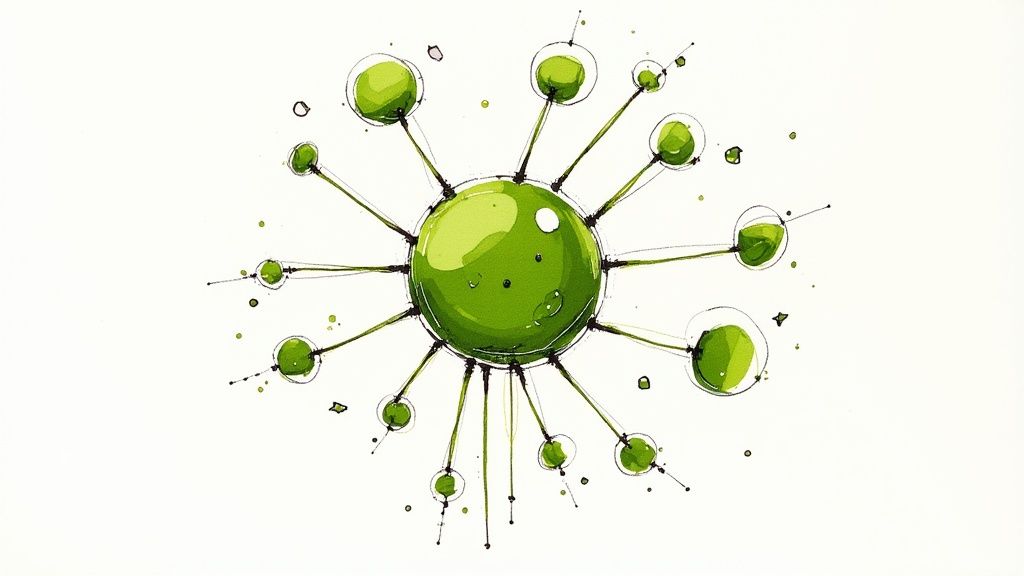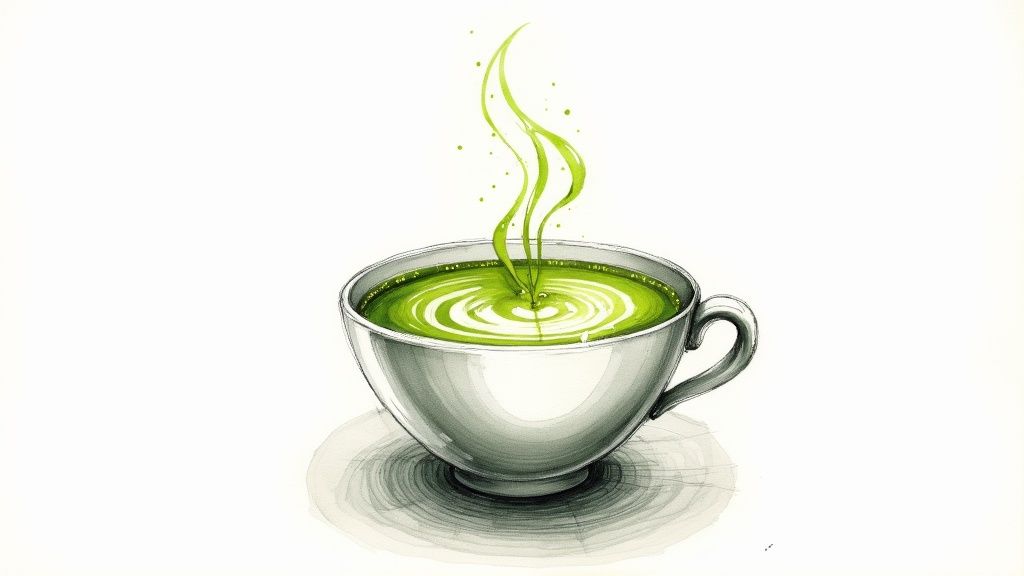The New Science of Cognitive Enhancement Through Matcha
As interest in matcha continues to grow, scientific research is backing up what tea drinkers have long experienced – this finely ground green tea can significantly boost brain function in unique ways. Recent studies are revealing exactly how matcha works to enhance focus, memory, and mental clarity. Let's explore the science behind these remarkable cognitive benefits.
The Dynamic Duo: L-Theanine and Caffeine
The cognitive magic of matcha comes from two key compounds working together – L-theanine and caffeine. While caffeine provides mental stimulation, L-theanine (an amino acid found primarily in tea) promotes relaxation without drowsiness. Together, they create a balanced state of alert calmness. You get the heightened focus and energy from caffeine, but without the jitters or anxiety that coffee can cause. This makes matcha perfect for activities requiring sustained concentration, from studying to creative work to getting through a busy day at the office.
Optimizing Your Matcha Intake for Peak Performance
Getting the most cognitive benefit from matcha is all about timing. Having your matcha about an hour before mentally demanding tasks allows the L-theanine and caffeine to reach optimal levels in your system, setting you up for peak mental performance. Many people find combining matcha with breakfast helps maintain steady energy and focus through the morning. For more details on incorporating matcha into your routine, check out: How to master incorporating matcha into your diet. Since everyone responds differently to caffeine and L-theanine, take time to find the schedule and amount that works best for you.
From Students to Professionals: Matcha's Broad Appeal
Matcha's cognitive benefits make it valuable for many different types of people. Students appreciate the improved concentration and memory retention during study sessions. Professionals enjoy better productivity and reduced stress when tackling complex work. Many are switching from coffee to matcha because it provides steadier, longer-lasting energy without the crash. Think of it like the difference between sprinting and running a marathon – matcha helps you maintain consistent mental stamina throughout the day.
Matcha: A Natural Cognitive Enhancer
Beyond the immediate mental boost, research indicates matcha may support long-term brain health. Its powerful antioxidant compounds, especially EGCG, help protect brain cells from oxidative damage that can contribute to age-related cognitive decline. By making matcha part of your healthy lifestyle, you're not just sharpening your current mental function – you're investing in maintaining your cognitive abilities as you age.
Understanding Matcha's Superior Antioxidant Profile
Matcha isn't just a delightful part of Japanese tea ceremonies – the science behind its health benefits is fascinating. When it comes to antioxidant content, matcha consistently outperforms other acclaimed superfoods in lab tests. The reason lies in how this bright green powder is grown and processed, particularly in its high levels of epigallocatechin gallate (EGCG).
The Power of EGCG and Other Catechins
At the heart of matcha's antioxidant strength is EGCG, a powerful type of catechin. These natural compounds help protect your cells by neutralizing harmful free radicals – unstable molecules that can damage cells through oxidative stress. When left unchecked, this damage may lead to various health issues. A single cup of matcha contains about three times more antioxidants than regular green tea, thanks to the unique way it's grown in shade and consumed as whole leaves rather than just an infusion.
From Shade to Sip: Maximizing Antioxidant Potential
The weeks before harvest make all the difference in matcha's antioxidant content. During this time, tea farmers cover the plants to block direct sunlight. This practice triggers some remarkable changes – the leaves produce more chlorophyll (giving matcha its vivid color), boost their amino acid content (including L-theanine), and significantly increase their antioxidant levels as a natural defense mechanism. If you want the highest concentration of these beneficial compounds, opt for ceremonial grade matcha, which comes from the youngest, most tender leaves.
Practical Tips for Optimal Antioxidant Absorption
Getting the most out of your matcha requires proper preparation. Water temperature is key – aim for about 175°F, as boiling water can break down the delicate antioxidant compounds. The traditional bamboo whisk method isn't just for show – it creates a smooth, clump-free drink that helps release more of the beneficial compounds. For an extra antioxidant boost, try pairing your matcha with vitamin C-rich foods like berries or citrus fruits, which can help your body better absorb these protective compounds.

Beyond the Basics: Matcha and Cellular Health
The benefits of matcha's antioxidants extend far beyond immediate effects. By regularly protecting your cells from oxidative damage, matcha may help lower your risk of several chronic conditions, including heart disease and certain cancers. While researchers continue studying the long-term impact of regular matcha consumption, current evidence suggests this ancient tea offers genuine health benefits when included as part of a balanced diet. As scientists uncover more about how matcha's compounds work in the body, we're likely to discover even more reasons to enjoy this remarkable green tea.
Understanding Heart Health Benefits of Daily Matcha
Regular matcha consumption offers unique and well-researched heart health benefits thanks to its bioactive compounds. Research shows that these compounds work together in complementary ways to protect cardiovascular function at multiple levels, making matcha an especially effective addition to heart-healthy routines.
Key Pathways for Cardiovascular Protection
At the core of matcha's heart benefits is its exceptional antioxidant content, particularly a compound called EGCG. These antioxidants help prevent oxidative stress damage to blood vessel walls that can lead to cardiovascular problems. When blood vessels are protected from this type of injury, they maintain better blood flow and overall function. Studies also point to matcha's positive effects on blood pressure and cholesterol – two major markers of heart health that respond well to daily matcha drinking.
How Matcha Helps Balance Cholesterol
The research on matcha and cholesterol management is particularly compelling. Regular consumption appears to help maintain healthy levels of both LDL (often called "bad" cholesterol) and HDL ("good" cholesterol). Think of your circulatory system like a network of roads – matcha helps keep traffic flowing smoothly by managing cholesterol buildup that could otherwise create dangerous bottlenecks. By supporting this delicate balance, matcha reduces the risk of plaque accumulation in arteries, a condition known as atherosclerosis.
Supporting Blood Pressure and Arterial Health
Beyond its cholesterol-balancing effects, matcha shows promise for maintaining healthy blood pressure – another crucial aspect of heart wellness. High blood pressure can stress the cardiovascular system over time, but matcha may help keep levels in check. The antioxidants in matcha also protect artery walls by reducing inflammation and oxidative damage. This multi-layered protection helps prevent arterial stiffening and maintains good blood flow throughout the body.
Making Matcha Part of Your Heart-Healthy Routine
Starting your day with matcha is a simple way to support long-term heart health. While matcha alone isn't a complete solution, it works well as part of an overall heart-healthy lifestyle that includes regular physical activity, plenty of fruits and vegetables, and effective stress management. Consider talking with your doctor or nutritionist about the best way to incorporate matcha into your personal wellness plan. They can help you determine the right amount based on your specific health needs and goals.
Mastering Digestive Wellness Through Matcha

Many people enjoy matcha for its rich, earthy flavor, but this bright green tea powder offers much more than just great taste. Research shows that matcha provides key benefits for digestive health by supporting good bacteria growth, helping your body absorb nutrients better, and keeping your gut balanced. Adding matcha to your daily routine is a simple way to boost your digestive wellbeing.
The Gut-Boosting Power of Matcha's Polyphenols
The concentrated polyphenols in matcha, especially EGCG, directly support a healthy gut environment. These natural compounds act like food for the good bacteria living in your digestive system. Studies show they specifically help grow beneficial strains like Lactobacillus and Bifidobacterium – bacteria that are essential for proper digestion and immune function. By feeding these helpful microbes, matcha helps create the right conditions in your gut to reduce discomfort and get the most nutrition from your food.
Enhancing Nutrient Absorption With Matcha
Matcha does more than just support good bacteria – it also helps your body better absorb nutrients from food. Research indicates that matcha's polyphenols help strengthen the lining of your intestines. This means your body can more effectively take in vitamins and minerals from what you eat. Matcha also gently stimulates digestion, promoting regular bowel movements that keep things moving smoothly. These combined benefits help your digestive system work more efficiently.
Matcha: A Natural Aid For Digestive Balance
A balanced gut microbiome is key for overall health, and matcha provides natural support for this delicate ecosystem. Its mix of fiber and polyphenols helps beneficial bacteria thrive while clearing out harmful compounds. This promotes harmony in your digestive tract and can reduce common issues like bloating and irregularity. Some research also suggests that matcha's calming effects may ease digestive problems triggered by stress, offering a well-rounded approach to gut health.
Incorporating Matcha For Optimal Digestive Health
To get the most digestive benefits from matcha, timing and preparation matter. Many people find that drinking matcha in the morning helps kick-start digestion for the day. Having it after meals can also aid food breakdown. Try blending matcha into smoothies with gut-friendly ingredients like yogurt, fruits, and vegetables to create an extra-powerful digestive boost. Experiment to find enjoyable ways to make matcha part of your daily routine that work best for your body and schedule.
From Leaf to Cup: The Art and Science of Quality Matcha
The remarkable qualities of matcha tea come from the careful steps taken in its journey from garden to teacup. When we understand this process, we can better appreciate what makes exceptional matcha special and get the most health benefits from every serving.
Cultivating Excellence: The Matcha Growing Process
Growing premium matcha starts with following time-tested methods passed down through generations. The key difference from regular green tea happens several weeks before harvest, when farmers shade the tea plants from direct sunlight. This simple but important step causes fascinating changes in the leaves – they produce more chlorophyll, giving matcha its beautiful green color, and create higher levels of L-theanine amino acids. The shading also boosts the plants' production of natural antioxidants that support good health.
Grades of Matcha: Understanding the Nuances
After harvest, skilled producers carefully process the leaves into the fine powder we know as matcha, but quality can vary significantly between different grades. Ceremonial grade matcha, made from the youngest and most tender leaves, offers a fresh green color, silky smooth texture, and naturally sweet, subtle flavor. This highest grade delivers the purest taste and richest nutrients. Culinary grade matcha works well in lattes, smoothies and baked goods, with a slightly stronger taste while still providing many health benefits.
From Harvest to Powder: The Matcha Production Process
Right after picking, the leaves are quickly steamed to stop oxidation and lock in their vivid green color and nutrients. Workers then remove stems and veins, keeping only the most pristine leaf portions. The final step uses traditional granite stone mills to slowly grind the leaves into an incredibly fine powder. While this careful grinding takes time, it preserves matcha's delicate flavors and beneficial compounds.
Preserving the Power: Storage and Preparation Techniques
To keep matcha fresh and potent, proper storage makes all the difference. Use an airtight container and keep it in a cool, dark, dry spot away from light, moisture and air that can make it lose flavor and nutrients. When making matcha, water temperature plays a key role – too hot and it becomes bitter while destroying delicate nutrients. The sweet spot is around 175°F. A bamboo whisk called a chasen isn't just for show – it creates the perfect frothy texture that brings out matcha's best qualities and helps release its healthy compounds. Taking care with storage and preparation lets you get the most enjoyment and benefits from this special tea.
Creating Your Personal Matcha Success Strategy

Matcha tea offers remarkable benefits for cognitive function, heart health, digestion, and antioxidant protection. But getting the most out of matcha requires finding an approach that works for your unique needs and lifestyle. By developing a personalized plan, you can create sustainable habits that help you enjoy matcha's benefits consistently.
Defining Your Matcha Goals
Start by getting clear on what you want to achieve with matcha. Are you looking to boost your mental focus and productivity? Support your heart health? Improve your digestion? Or simply add a healthy, delicious beverage to your daily routine? Having specific goals will help guide how you incorporate matcha into your day.
For instance, if you want better concentration at work, try having matcha before important tasks to benefit from the combined effects of L-theanine and caffeine. If you're focused on digestive health, you might prefer drinking matcha after meals to support digestion. The key is matching your matcha habits to your personal health priorities.
Exploring Matcha Preparation and Consumption Methods
While the classic preparation involves whisking matcha powder with hot water to create a frothy green tea, this versatile ingredient works well in many different recipes and preparations. Finding your preferred way to enjoy matcha helps make it a natural part of your routine.
Here are some popular ways to incorporate matcha:
- Matcha Lattes: Mix with your choice of dairy or plant-based milk for a creamy drink
- Matcha Smoothies: Blend into morning smoothies for an antioxidant boost
- Matcha Baking: Add to cakes, muffins and treats for color and nutrients
- Matcha Oatmeal: Sprinkle into breakfast oats for flavor and health benefits
Addressing Potential Challenges and Adapting to Your Lifestyle
While matcha offers many benefits, it's important to address any obstacles that could derail your matcha routine. Some find the taste too bitter at first. Others may need to moderate caffeine intake. Planning ahead helps you overcome these hurdles.
Here's a practical guide for common challenges:
| Challenge | Solution |
|---|---|
| Bitter Taste | Add a natural sweetener like honey or maple syrup, or blend with fruits. |
| Caffeine Sensitivity | Start with a smaller amount of matcha and gradually increase your intake. |
| Preparation Time | Pre-portion matcha into individual servings for quick and easy preparation. |
By taking these challenges into account and finding solutions that work for you, matcha can become an enjoyable part of your daily wellness routine. This personalized approach helps you get consistent benefits from your matcha practice.
